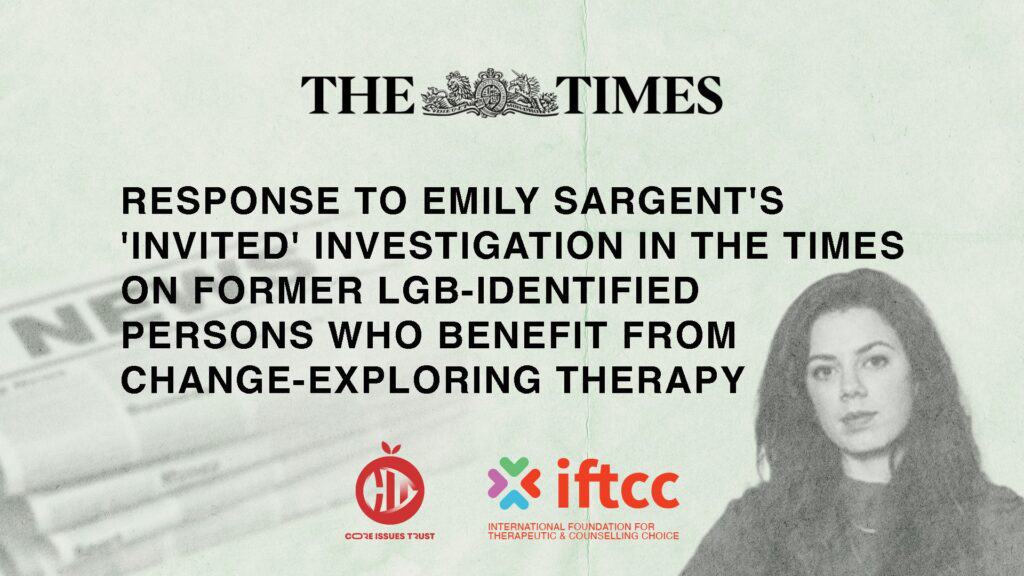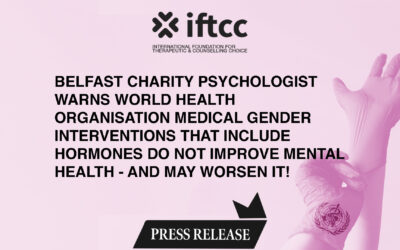
Dr Laura Haynes, PhD
Chair, IFTCC Science and Research Council
Journalist Emily Sargent, in her investigation for the Times, confessed she lied undercover. She did not experience “conversion therapy” as she claims. She experienced lying to someone. She experienced setting someone up. She experienced intentionally setting up a conversation in which two people were speaking past each other. Emily’s perspective is that her same sex attraction is who she is and she is happy with her lesbian identity. She asked for a conversation that was not for her.
People who benefit from change exploring therapy generally do not take an LGB identity. They view their same sex attraction as feelings they have, not who they are. They are as resolved/unresolved in their integration of their religion and sexuality as people who accept an LGB identity. Some have experienced having therapy with an affirmative therapist who tried to get them to accept an LGB identity as who they are and to change their religion. They have reported they felt harmed and not affirmed. (Nicolosi et al., 2000) If a non-LGB-identified person went undercover to an affirmative therapist for help to “accept who I am”, I suspect they would feel as Emily felt. Such a person would not have experienced affirmative therapy.
Studies are increasingly confirming that there are different subgroups of same sex attracted people. Those who take an LGB identity generally believe their same sex attraction is inborn and who they are. Those who do not take an LGB identity view their same sex attraction feelings as feelings they have, not who they are. They do not believe they were born that way. For them, responses on a “homonegativity” questionnaire likely express assent to religious beliefs, not beliefs about self. Religion is associated with health for them, whereas for LGB identified, there is almost no such association. Non-LGB-identified people of traditional religious beliefs are no less mentally healthy, satisfied with life, and flourishing. They experience change-exploring therapy as more helpful. (Barringer & Gay, 2017; Lefevor, Beckstead, et al, 2019; Levefor, Sorrell, et al, 2019; Rosik, Lefevor, & Beckstead, 2021; Rosik et al, 2021)
Studies of individuals in this population in change-exploring therapy have found that psychological well-being improved significantly, strongly, and clinically. Self esteem increased, and depression and suicidality decreased. (Jones & Yarhouse, 2012, p. 424; Pela & Sutton, 2022; Sullins, Rosik, & Santero, 2021)
Studies that claim “sexual orientation change efforts (SOCE)” are harmful survey largely or solely people who currently identify as LGB. Therefore they systematically exclude formerly LGB identified people who changed and would say they benefited. This is like surveying only people who had marriage counselling and subsequently divorced to find out if marriage counselling is safe and effective, as Rosik has pointed out. (Rosik, 2023)
In addition, studies that claim harm have said that people who go to SOCE have experienced more lifetime suicidality than people who have not gone for SOCE. Then they claim the pastoral or professional counselling caused the lifetime suicidality. But when research has compared how much of that lifetime suicidality was before versus after SOCE, it has found that most of the suicidality was before SOCE, not after. Unsurprisingly, people who are more suicidal go to counselling more than people who are not suicidal. The same is likely unremarkably true for people who go to affirmative counselling or any counselling. SOCE did not increase suicidality and may have decreased it, potentially dramatically. And this finding is in people who currently identify as LGB—in people who did not change. (Sullins 2022a, 2022b, 2023a, 2023b)
There are a number of reasons some people seek therapy to explore their potential to manage, decrease, or change their same sex attraction or behaviour. The most common reason people seek change exploring therapy is to protect their marriage to their opposite sex spouse whom they love and to keep their family together so they can go on being full time moms and dads. (Pela & Sutton, 2022; Sullins, Rosik, Santero, 2021) Abundant research has documented that most same sex attracted people are both sex attracted, and exclusively same sex attracted are the exception. (Tolman & Diamond, 2014, vol. 1, p. 633) Most both sex attracted people who are in a relationship are with the opposite sex. (ONS, 2012-2020, Table 5b; Jones, 2022, pp. 5-6; Kaestle, 2019, figure 3 and p. 819) Their sexual attraction commonly shifts or changes toward or heterosexual. (Tolman & Diamond, APA Handbook, 2014, v. 1: pp. 636, 562, 619) The number of people who may need or want change-exploring therapy at some time is not negligible. Minors may seek this help because they aspire to live in a procreative relationship. The second most common reason for seeking change exploring therapy is to live consistently with one’s religious faith that gives one’s life meaning and that should be respected. (Pela & Suton, 2021) A view that traditionally religious people are uniquely incapable of making choices based on self knowledge, love of their spouse and children, aspiration to a procreative relationship they want, and love of the beauty of their religion is itself discriminatory.
Many non-LGB-identified people who have experienced change exploring therapy have experienced a decrease in opposite sex attraction or behaviour and/or increase in opposite sex attraction or behaviour, while fewer experience complete change, and some do not change. (Pela & Sutton, 2021; Sullins, Rosik, & Santero, 2021) Even a partial change can change a life by enabling some people to achieve their goal to be abstinent or in an opposite sex relationship more comfortably and easily and so live as they desire.
The UK government should not decide for same sex attracted people who they are and what will make them happy.
References
Download a PDF version of the full document and references here





